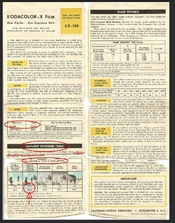But, to excerpt Alan's reply,
"I found a picture of the instruction sheet from Kodacolor X, ASA 64...the normal bright sunny is based at f/11 (EV14) at 1/125 which is f/16 at 1/60, the f/16 rule for ASA 64."
1/ISO f/16 (Sunny 16 rule) is virtually same as 'ASA 64 at 1/60 f/16', so I do not understand where the 'sun brighter then' comment comes from.
Within the past year I did a series of incident reading on various 'sunny' days at about Latitude 38, and validated that depending upon the day 'Sunny 16 was pretty 'rule of thumb'; IIRC, the range measured about f/11 + 0.5EV to f/15 + 0.5EV
Being a resident of USA, I find it surprising that Sunny 16 only applies at Latitudes NORTH of Portland OR

which excludes most of the US landmass.













 which excludes most of the US landmass.
which excludes most of the US landmass.